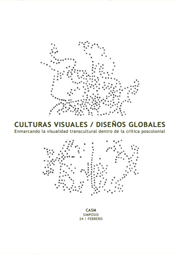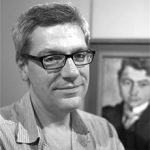Framing Transcultural Visuality: Anthropology, Visual Culture, Postcolonial Critique
I Annual Symposium
February 24, 2007, Barcelona, Spain
Organizing Team
Keynote Speakers
Matthew Rampley, University of Teesside, Middlesbrough
Juan Vicente Aliaga, Polytechnic University of Valencia
Joaquín Barriendos, Universitat de Barcelona
José Luis Brea, Universidad Carlos III
Miguel Ángel Hernández, CENDEAD
Anna Maria Guasch, Universitat de Barcelona
Carles Guerra, Universitat Pompeu Fabra
Fernando Hernández, University of Barcelona, Spain
Efraín Foglia, Universitat de Vic
Alex Bauzá, University of Barcelona, Spain
Andrea Díaz, University of Barcelona, Spain
Moderators
Joaquin Barriendos, University of Barcelona, Spain
Aida Sánchez, University of Barcelona, Spain
Cristián Gómez Moya, University of Barcelona, Spain
Conveners
Joaquin Barriendos, Columbia University, Nueva York
Anna Maria Guasch, Universitat de Barcelona
With the support of:
Arts Santa Mònica
Ministerio de Ciencia y Educación / HAR2010-17403 / 2011-2013
University of Barcelona, Departament de Historia de l’Art
Program
OPEN KEYNOTE TALK
10:30 / Matthew Rampley
Against Difference. On Some Difficult Questions for Postcolonial Culture
Moderator: Aida Sánchez
TABLE 1
12:00 / Fernando Hernández
Visualizing Cultural Difference in a Global Narrative Framework: HSBC’ ‘Local Knowledge’: A Case Study
13:00 / Joaquín Barriendos
Rethinking Levi-Strauss’ Idea of ‘Split Representation’ (from the point of view of the Visual Studies)
TABLE 2
17:00 / Miguel Ángel Hernández
Secondhand Technology: Non-Synchronic Visualities. ‘Move: Migratory Aesthetics’
17:30 / José Luis Brea
RAM Cities. One Thousand Screens
18:00 / Efraín Foglia
Global Art within Hybrid Realms
Moderator: Joaquín Barriendos
TABLE 3
17:45 / Carles Guerra
Global Public Opinion. Between an Empirical and a Theological Aeshtetic
19:45 / Àlez Bauzà
Formula and Intention: Evidency and Quiesence of an Image
20:15 / Andrea Díaz
Subjetivity, Alterirty, Globality
Moderator: Cristián Moya
 Despite the fact that this symposium takes into account the fruitful (but also confusing) discussion regarding the interdisciplinar study of visual cultures ―that has risen in part due to the conflicts between art history and the institutionalization of visual studies, its goals are more closely related to the interplays between visuality, current global processes and transcultural negotiations. The epistemological debate that arose around the idea of Universal (Art) History and the questionable existence of global art, will therefore be re-framed during these talks within postcolonial critique of global visual designs. By reconsidering visual studies from the point of view of the transcultural arena, VC/GD aims to deactivate the common belief that cultures and subjects are inside of a geopolitical network situated beyond the global conflict defined by Aníbal Quijano as the ‘coloniality of power’.
Despite the fact that this symposium takes into account the fruitful (but also confusing) discussion regarding the interdisciplinar study of visual cultures ―that has risen in part due to the conflicts between art history and the institutionalization of visual studies, its goals are more closely related to the interplays between visuality, current global processes and transcultural negotiations. The epistemological debate that arose around the idea of Universal (Art) History and the questionable existence of global art, will therefore be re-framed during these talks within postcolonial critique of global visual designs. By reconsidering visual studies from the point of view of the transcultural arena, VC/GD aims to deactivate the common belief that cultures and subjects are inside of a geopolitical network situated beyond the global conflict defined by Aníbal Quijano as the ‘coloniality of power’.
It is clear that without a critique of current global visual designs, postcolonial geopolitical shifts will only result in new social inequalities. By promoting new interplays between transculturality and visual studies we attempt to improve the capability of critical theory to undermine the resurgence of a strengthened and revitalized identity politics. In this framework, the transcultural perspective of visual studies should go beyond ideological pluralism and liberal multiculturalism. Moreover, an effort will be made to reconsider the study of visual cultures as a counterweight to the epistemological turbulences derived from issues such as anthropological description, ethnographic distance, representative balance, and etcetera.
The point of departure of the first symposium has to do with recognizing that the anthropological dimension of visuality is filled with traps we can’t ignore. That’s the reason for assessing carefully the suspicions that have risen as a consequence of what has been described (in part because of the influence of Hal Foster’s perspective) as the ethnographic turn. Despite the fact that Martin Jay recognized the permanence and importance of the anthropological approaches in his response, for instance, to Octobers’ questionnaire on visual culture, he considered some anthropologic concepts as “imprecise and inadequate” points of departure. In this way, cultural differences, representation of otherness, recognition of alterities as well as diverse processes of identification and subjetivizacion, cannot become obstacles for the expansion, legitimization and concretion of visual extradisciplinariety.
Including specific cases of study and complementary proposals from different disciplines, the VC/GD symposium has been conceived as a place to share new approaches to these issues. If it is true that the recognition of different visual cultures allows a gradual deactivation of essentialist discourses ―like the clash of civilizations― it will feasible to recognize, as Matthew Rampley has suggested, the usefulness of visual studies for the development of postcolonial criticism. Considered from this perspective, the anthropological dimension of visuality could tend to start to cease being the guardian discourse of visual studies.

Opening Speech:
Matthew Rampley
Matthew Rampley was awarded his first degree by the University of Oxford where he combined the study of German and Ancient Greek. He later continued on to complete a PhD in German philosophy, specifically, the aesthetic thought of Friedrich Nietzsche, at the University of St. Andrews. He has been at the University of Birmingham since April 2010. Before arriving to Birmingham he worked at the University of Teesside, having previously taught at University College of the Creative Arts and Edinburgh College of Art. His main teaching and research interests are in contemporary art, art criticism and theory, as well as the art and architecture of central Europe of the nineteenth and twentieth centuries. He am currently working on two particular projects: (1) museums and cultural politics in the later Habsburg Empire; (2) the relation between art theory and the biological sciences.
Venue
Centre d’Art Santa Mònica
La Rambla, 7, 08002 Barcelona, Spain
www.artssantamonica.gencat.cat
